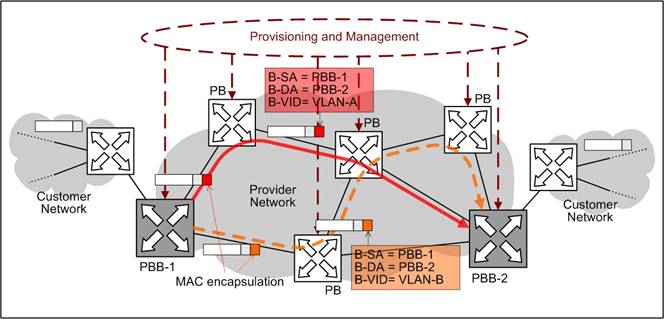|
|
Provider Backbone Bridge - Traffic Engineering (PBB-TE)
and Provider Backbone Transport (PBT)
The transformation of Ethernet from a LAN switching technology to a carrier-grade tool remains impractical with
IEEE 802.1ah-compliant PBBs. Although PBBs create a provider infrastructure that is transparent to the customer networks, they may still use techniques inherited from the LAN such as the Spanning Tree Protocol (STP) and MAC-learning. Such techniques do not meet the configurability requirements of carrier-grade operation. Thanks to the modularity of Ethernet specifications, they can be turned off to pave the way for the fine-tuning of management-based processes. Moreover, the creation of a service-provider MAC layer requires a redefinition of the VLAN space to fulfill carrier-grade requirements. The development of PBBs having an array of traffic engineering capabilities is currently underway through the ongoing
IEEE 802.1Qay amendment, also known as Provider Backbone Transport (PBT).
Spanning Tree Protocol (STP) Problem
Parallel paths between nodes may create forwarding loops leading to excess traffic or large peaks in broadcast traffic (broadcast storms). By defining a logical tree topology, STP specifies a unique path between any pair of nodes and disables parallel paths, thus eliminating loops. Disabled links are used for backup. Switches/bridges use special frames called Bridge Protocol Data Units (BPDUs) to exchange STP information. Rapid STP (RSTP) is an improved version of STP that achieves faster convergence by introducing measures such as more efficient BPDU exchanges. Rather than disabling parallel links as in STP and RSTP, Multiple STP (MSTP) exploits them by defining different spanning trees for different VLANs.
The STP variants described above are automatic distributed control-plane features that were not designed with traffic engineering requirements in view. Their continued use in PBBs is a serious hurdle to the use of PBBs in carrier-grade networks.
About VLAN Learning Processes
Like MAC address learning, VLAN learning enables Ethernet switches to dynamically associate new MAC addresses and VIDs with port information. To do so, VLANs maintain one or more filtering databases, depending on the learning process. Two VLAN learning schemes were specified in
IEEE 802.1Q: Independent VLAN learning (IVL) and Shared VLAN learning (SVL). For a defined subset of VLANs, SVL uses one common filtering database, hence enabling the sharing of port information among VLANs. IVL, on the other hand, uses one filtering database per VLAN, thus restricting MAC learning to the VLAN space. A notable consequence of IVL is that forwarding is effectively specified by the full 60-bit combination of the destination MAC address and the VID. In a carrier-grade environment, this represents a valuable scalability advantage.
Provider Backbone Transport (PBT)
In 802.1Qay, PBT is defined by a backbone architecture implemented together with a set of measures to enable traffic engineering. PBT relies on altered PBBs at the edge of the provider network and PBs to perform forwarding within its core. Rather than multicast trees, VLANs represent connection-oriented Point-to-Point (PtP) or MultiPoint-to-Point (MPtP) tunnels (Ethernet Switched Paths, ESPs) traversing the core from one PBB to another. A range of B-VIDs is reserved to identify the ESPs. Rather than having global significance, those B-VIDs are tied to destination PBB addresses (B-DA) and can be reused. At each provider switch, the egress port of a frame is determined by the 60-bit combination of B-VID and B-DA. For instance, reserving 16 out of the 4094 B-VIDs implies a theoretical maximum of 16 x 248 available ESPs. This eliminates the scalability limits of VLAN stacking and is considered sufficient for transport purposes.
To enable PBT, the following measures are necessary at the provider switches and within the range of B-VIDs allocated for ESPs:
- Disable automatic MAC learning and flooding so as to enable the configuration of forwarding tables at the management layer.
- Filter (remove) unknown-destination, multicast, and broadcast frames.
- Disable xSTP to allow for loops and alternate path-oriented resilience mechanisms.
- For a given destination PBB, assign a unique B-VID to each ESP.
- Activate IVL.
The latter measure disables MAC address sharing between VLANs. This prevents the egress port associated to one ESP to be altered by the configuration of an alternate ESP toward the same destination PBB. Consequently, at the provider switches, the egress port is locally determined by the full 60-bit B-VID/B-DA sequence.
Note that provider switches may revert to normal VLAN switching outside the prescribed set of B-VIDs. Moreover, ESPs need to be created in both directions to establish connection symmetry, a feature necessary for the proper operation of Ethernet customer networks.
PBT Illustration
The PBT architecture is illustrated in the example of Fig. 1. At the management plane, two paths are configured from PBB-1 to PBB-2 to interconnect two customer networks. The forwarding tables of all the traversed PBB and PB switches are updated accordingly. A distinct B-VID is assigned to each path.

Fig. 1. PBT example.
At PBB-1, customer frames are encapsulated: PBB-1, PBB-2, and either VLAN-A or VLAN-B are entered in the B-SA, B-DA, and B-VID fields, respectively. The customer frame is decapsulated and forwarded to the customer network at the destination edge node (PBB-2). In the provider network core, enabling IVL insures that PBs will maintain distinct routes for different B-VIDs although the same destination address appears, as is the case when VLAN-A and VLAN-B cross in Fig. 1.
The PBT architecture allows for total path configurability from source to destination. Multiple ESPs can be created between PBBs for traffic engineering, load balancing, protecting connections, and separating service/customer instances.
Further reading
- IEEE P802.1Qay, Draft 4.5, "IEEE Standard for Local and Metropolitan Area Networks---Virtual Bridged Local Area Networks - Amendment: Provider Backbone Bridge Traffic Engineering."
- IEEE 802.1Qay Task Group, http://www.ieee802.org/1/pages/802.1ay.html
|
|
|
|
| |